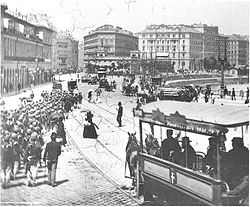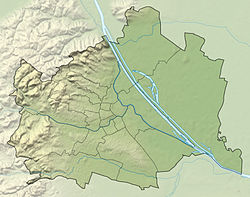Hotel Metropole
| Hotel Metropole | ||
|---|---|---|
 The Hotel Métropole on Morzinplatz (the block on the right) on an old photograph |
||
| Data | ||
| place | Vienna 1., Morzinplatz 4 | |
| architect | Carl Schumann , Ludwig Carpenter | |
| Construction year | 1873 | |
| height | 4 floors w | |
| Coordinates | 48 ° 12 '47.3 " N , 16 ° 22' 27.2" E | |
|
|
||
| particularities | ||
| The five-star hotel was the headquarters of the Gestapo from 1938 . It was destroyed in a bombing raid in 1945. | ||
The Hotel Metropole , also Hotel Metropol was a luxury hotel in Vienna , the first district , which today mainly as a former Gestapo -Leitstelle is known. In 1945 the building was badly damaged and the ruins were demolished after 1948.
Hotel history
The hotel was built in 1873 by the architects Carl Schumann and Ludwig Tischler for the world exhibition in Vienna at the place called Morzinplatz from 1888 near Franz-Josefs-Kai . (Before that, after the demolition of the city wall, the Treumann-Theater or Quai-Theater stood on this property from 1860–1863 .) The house was allegedly referred to by the locals as a “Jewish Sacher ” because its furnishings corresponded to the Hotel Sacher and the owner families Klein and Feix were Jewish. It was richly decorated with Corinthian columns , caryatids and atlases . The dining room in the courtyard was roofed with glass.
A famous guest was Mark Twain , who in 1897 spent part of his 20-month stay in Vienna there until May 1899. At the front to Franz-Josefs-Kai 33, Stefan Zweig's father ran the headquarters of his woven goods factory.
Gestapo headquarters
After the “ Anschluss ” of Austria, the hotel was confiscated in March 1938 by Reinhard Heydrich for the Gestapo, the most important instrument of Nazi terror in Austria. He set up the Vienna State Police Headquarters here (and decreed that the building should no longer be called Hotel Métropole). With 900 officers from the criminal police and many members of the SS , the house was the largest Gestapo office in the “ Greater German Reich ”; the Gestapo numbered around 18,000 officers. In 1938 the resistance group around Karl Burian planned the demolition of this Gestapo headquarters with the building plans of the hotel provided for this purpose by the former owner Markus Friediger, but the resistance group was arrested before the plan was implemented.
Over five hundred people had to come into the building every day for interrogation, and then risk imprisonment. During the interrogations and in the cells in the basement of the Hotel Métropole, the prisoners were sometimes severely tortured by the Gestapo officers. Physical and psychological abuse were the order of the day. And when the prisoners later cited torture and unworthy treatment at the People's Court hearings, they were not believed by the judges, for example at the hearing about the Austrian resistance group around chaplain Heinrich Maier . In the summer of 1938, the last Federal Chancellor of the corporate state , Kurt Schuschnigg , was imprisoned here for months before he was transferred to Munich. Schuschnigg “lived in” a room; he was guarded (in 8-hour shifts) by one guard and six officers at the same time, who had to keep this duty secret. (So 21 men were employed to guard Schuschnigg alone.) If a window was opened at the request of the prisoner, he had to stay in the room so that he could not be seen from the building opposite. He also had to be escorted to the corridor toilet by a guard; he was allowed to shave himself under guard.
From March 1938 to December 1944, the first head of the Vienna Gestapo headquarters was the Munich criminal inspector and SS brigade leader Franz Josef Huber , who was also the inspector of the security police and the SD . He was replaced by the SS-Standartenführer Rudolf Mildner . Despite their leading positions, both received only mild punishment after the war .
The management staff of the Vienna Gestapo consisted of about a third of Reich Germans until 1942 and from 1944 onwards, with a quarter in between. The majority of the management staff were selected from the previously "illegal Austrian National Socialists" and adaptable police officers of the Schuschnigg regime.
War damage and demolition
On March 12, 1945, the former metropolis burned down in the heavy air raid on Vienna . However, there are also testimonies according to which the fire, after relatively minor bomb damage, was started by the Gestapo itself at the beginning of April 1945 in order to destroy evidence. In the rubble film The Third Man , shot in Vienna in 1948, the ghostly ruins of the Gestapo headquarters can be seen in one shot. Then the remains of the building were demolished.
Coming to terms with and remembering after 1945
From 7 to 21 September 1947, the lawyer and former resistance fighters as prisoners taught the Gestapo Clemens Pausinger in the Regional Court Vienna Criminal one exhibition that employees Gestapo were put on display in the former over 1000 photos. In addition, a model of the former Gestapo control center with numbered interrogation and detention rooms was set up. It was hoped that former prisoners would give information about what was going on there in order to support the slow pursuit and investigation of members of the Gestapo. The exhibition was so well attended that the population was asked, in order not to obstruct court operations, to only fill out registration forms and to refrain from speaking to the examining magistrate in person.
After the project to erect a memorial for the victims of the National Socialist regime was repeatedly delayed or failed, a memorial stone was erected and unveiled on Morzinplatz in 1951 as part of a political rally by the concentration camp association without permission. It bore the inscription:
“Here was the Gestapo house.
It was hell for the confessors of Austria;
for many of them it was the forecourt of death.
It sank in ruins like the 1000 year old empire.
Austria has risen again, and with it
our dead, the immortal victims. "
In 1985, this memorial stone was replaced by the city of Vienna with the monument that exists today. It consists of a bronze figure, which is surrounded by eight granite blocks. The top block is labeled “Never Forget” and is flanked by a red triangle and a Jewish star. Another block bears the inscription of the first memorial stone. The memorial was designed by Leopold Grausam .
On June 13, 2015, in the course of an art campaign, commemoration and panel discussion as part of the Wiener Festwochen theater festival, a memorial was erected for the group of survivors, who in 1951 had erected an unapproved memorial for those murdered by the Gestapo on Morzinplatz (see above ).
The heptagonal memorial stone bears the inscription: What she failed to do, we did. The erectors of an obelisk that was never erected on April 11, 1951 at 7:20 p.m. The inscription quotes from a report in the journal of the concentration camp association Der Neue Mahnruf from 1951: “It was generally noticed that this memorial stone, commemorating the death of many thousands of Viennese patriots remembered, was not taken into custody by an official representative of the Viennese municipal administration. This can only surprise those who do not know that our association has been trying for years, unfortunately unsuccessfully, to get the Vienna municipal administration to erect a memorial at this point of their own. What she failed to do, we did. ”The action was also intended to highlight the lack of a memorial for the homosexual and transgender victims of National Socialism.

In 1968 the Leopold-Figl-Hof was built on the property , named after Leopold Figl , the first Federal Chancellor of the Republic of Austria after the Nazi era. On the side of the building facing Morzinplatz there is a memorial relief for the victims of National Socialism. On the other side of the block, at Salztorgasse 6, a memorial room was set up, which was renovated in 2011 and supplemented by a newly designed exhibition about the Hotel Métropole and its prisoners. It is looked after by the documentation archive of the Austrian resistance .
The name “Hotel Métropole” has not been chosen for any Viennese hotel since the war.
Media reception
In Stefan Zweig's Schachnovelle (1941), the Hotel Métropole plays a central role as Gestapo headquarters with its inhuman conditions of solitary confinement and interrogations. A large part of the film Schachnovelle , which is based on the novella, is set in a very luxurious hotel in Vienna, which is not mentioned and which is used as an office of the Gestapo. Some scenes from the novel Der Trafikant (2012) by Robert Seethaler take place in or in front of the Hotel Métropole after it was converted into Gestapo headquarters after the "Anschluss". Fritz Lehner has dealt most extensively with the hotel so far in his romantic trilogy Hotel Metropol (published 2005–2006).
Web links
- Electronic documentation for the exhibition in the memorial room on the website of the Documentation Archive of Austrian Resistance
- Gestapo headquarters in Vienna in the Vienna History Wiki of the City of Vienna
- http://www.planet-vienna.com/spots/morzinplatz/morzinplatz.htm
- Ilse Huber: From luxury hotel to Gestapo headquarters. In: Ö1 Hörbilder . March 17, 2018, accessed April 18, 2018 .
Individual evidence
- ^ Carl Schumann , architektenlexikon.at.
- ↑ Georg Markus : Murderer in the luxury hotel , in: Daily newspaper Kurier , June 5, 2011, p. 24.
- ↑ Telepolis: Messages from the Entrance to Hell ( Memento of July 18, 2008 in the Internet Archive ) , accessed on October 25, 2010.
- ^ Adolph Lehmanns Wiener Adressbuch, edition 1894, Volume 2, p. 1230, digital p. 1291 .
- ^ A b Wolfgang Neugebauer: The Nazi Terror System , in: Vienna 1938. Historical Museum of the City of Vienna, 110th Special Exhibition , Österreichischer Bundesverlag, Jugend und Volk, Vienna 1988, ISBN 3-215-07022-7 , p. 223 ff.
- ↑ See DÖW yearbook (2012), p. 37.
- ↑ See judgment of the People's Court GZ 5H 96/44 u. a., p. 21ff.
- ↑ Guard regulation ... for Federal Chancellor Kurt Schuschnigg, September 8, 1938 , in: Documentation archive of the Austrian resistance (ed.): "Anschluss" 1938. A documentation , Österreichischer Bundesverlag, Vienna 1988, ISBN 3-215-06824-9 , P. 533 f.
- ↑ "Main and back entrance of remembrance", feature on ORF Radio Ö1, Saturday, March 17, 2018, 09:05 - 10:00.
- ↑ Joachim Riedl : Traces in No Man's Land , in: Die Zeit , December 16, 2010, Austria edition, p. 15.
- ^ Gestapo exhibition in the Regional Court for Criminal Matters in 1947. (No longer available online.) Vienna City and State Archives (Municipal Department 8), archived from the original on October 15, 2017 ; accessed on October 14, 2017 .
- ↑ Memorial stone for victims of fascism in the Vienna History Wiki of the City of Vienna .
- ↑ Memorial Never Forget for the victims of the Gestapo in the Vienna History Wiki of the City of Vienna .
- ↑ Memorial stone What she failed to do, we did in the Vienna History Wiki of the City of Vienna .



